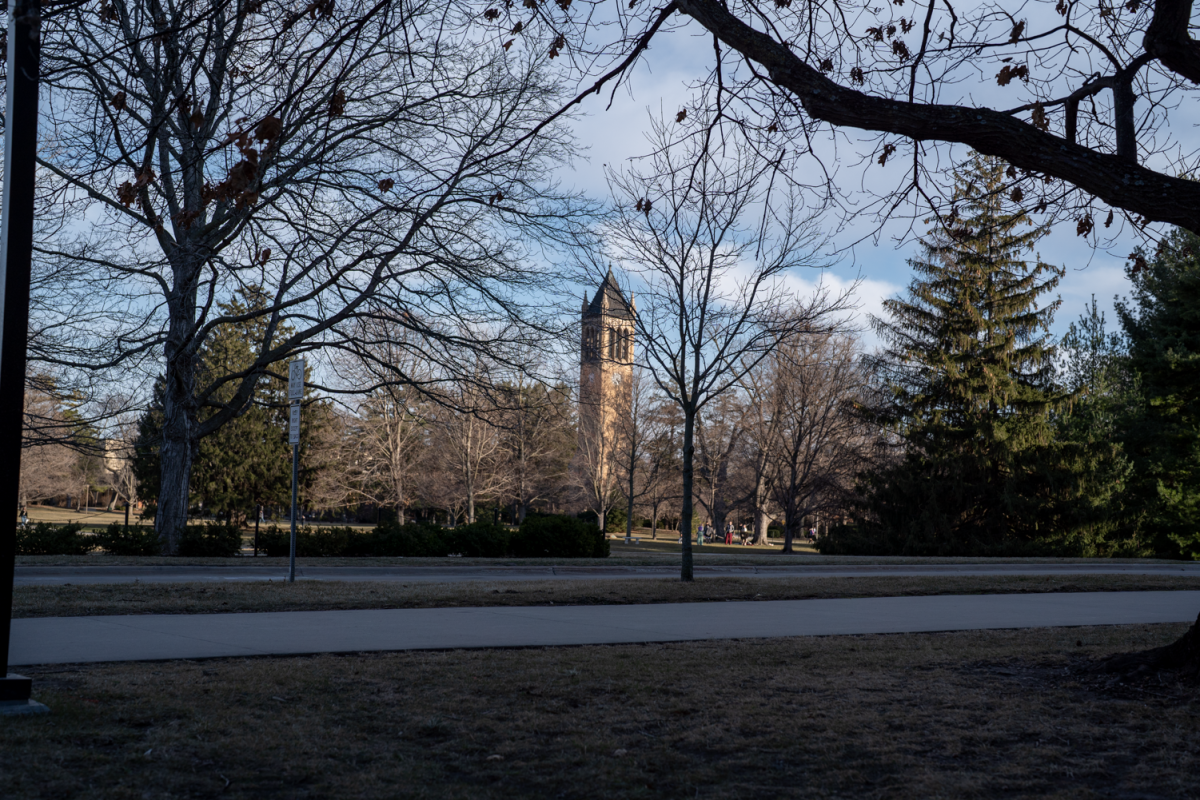Is alternative dead?’
November 19, 1998
No one in the mainstream is making new music anymore. Alternative rock has lost its passion; the entire genre is at a standstill, and the future remains on the line.
The demise of alternative rock lies ahead, and there’s nothing that can be done about it — that’s the consensus among music insiders.
“Alternative rock now really isn’t an alternative — it represents the mainstream, and it’s lost a lot of its juice because of that,” rock critic Greg Kot says. “Now it’s a marketing term, and it’s literally meaningless.”
As a music journalist for nearly 20 years, Chicago Tribune reporter Kot has closely monitored the industry, writing articles for the Tribune, Rolling Stone, Details and Guitar World, among others.
“I think what you’re seeing now is a lot of bands who are sort of clone versions of this early, first wave of alternative bands — Red Hot Chili Peppers, Jane’s Addiction — those bands have all had numerous imitators since they came up,” Kot says.
Rusty Poehner is coordinator for The M-Shop, a small, all-ages Ames venue that has hosted alternative acts such as Smashing Pumpkins, Soul Asylum and Cake. She says the meaning of alternative has completely changed.
“Originally, it was intended to be a response against the major labels and the niche marketing of music that’s still going on even more fiercely now,” Poehner says. “It was supposed to indicate genuine product as opposed to something the A&R [executives who sign new bands] schmucks in suits in L.A. thought up … alternative means ‘the kids will buy it.'”
Even widely known artists believe alternative just isn’t what it used to be, and this idea is revealed in a recent MTV News interview with Billy Corgan and James Iha of the alternative mainstays Smashing Pumpkins.
“Alternative rock just doesn’t seem so fresh anymore,” Iha says. “There was like a great wave … Pearl Jam, Nirvana and we were in that, but there just doesn’t seem to be any bands carrying the torch, no great bands.”
One-hit wonders are ruling the radio waves. And music industry business people are realizing that these groups are the easiest way to make a quick buck. The only prerequisite for artists to get radio airplay is a catchy guitar riff, a pop-infused chorus and a likable image.
“In terms of an emotional kind of level, we’ve reached this point where everyone’s kind of not sure what to do, so everyone keeps doing the same types of things,” Corgan says. “Alternative rock is at its post-modern, post-ironic … it’s like up against a wall.”
Examining the recent trends in music, the last truly innovative bands broke into the mainstream during or before 1994. Artists like the in-your-face politically-charged Rage Against The Machine and alt-folkster Beck were the last ones to push the envelope and create music that generated controversy and buzz.
“I talked to Beck a week ago, and I asked him point-blank, ‘Is this an exciting time for music?’ and he said, ‘No. It’s not,'” Kot says. “I think an ideal time for music is when bands are taking the risks and really pushing the limits of it, forcing other bands to keep up. We haven’t had a time like that in 15 years because everybody’s trying to fit in right now. Nobody’s trying to jump out. Nobody’s taking risks.”
Risks were the foundation of alternative rock, and Kot says artists like the Velvet Underground in the ’60s, Iggy Pop and the New York Dolls in the ’70s and Husker Du and Sonic Youth in the ’80s planted the seeds for music the industry would call alternative rock.
Smells like a revolution
All it takes is one band to pave the way, and that’s what Nirvana did in 1991 with its groundbreaking album “Nevermind.” Cutting through the noise of pop boredom, Nirvana gave listeners something refreshing and different — an alternative. That’s the term the record industry would use to define it.
The success of Nirvana prompted a generation of artists to ditch the limited boundaries of pop music, pick up guitars and play music in its purest form — unrestrained and free.
“Originality wasn’t the strong point of Nirvana,” Kot says. “It’s just the way they combined their influences was very unique, and I don’t think you’re seeing that anymore. You’re just seeing blatant copies of a lot of these early ’90s bands.
“I think the print media played a big role in laying the groundwork for Nirvana,” Kot says. “When ‘Nevermind’ arrived, that record was completely ignored by commercial radio and MTV, but the word of mouth buzz on that record was so strong. I know that there were reviews coming out on that record that were just over the top, saying that this is an amazing record. The print media laid some important groundwork about Sub Pop [the Seattle independent label that had Nirvana first] and grunge and the arrival of those kinds of sounds.”
Then it happened — BANG. Kurt Cobain shot himself in the head, devastating millions of fans and leaving hundreds of clone bands wondering what kind of music to play and who to mimic.
To top it off, Sub Pop Records, the indie label that spawned Nirvana, is going under, according to a recent Rolling Stone article.
Since 1997, Sub Pop has shut down offices in Boston and London and fired or laid off more than a dozen employees, the story reports.
“We established ourselves by mocking corporate culture, but we became what we mocked,” says Bruce Pavitt, who founded the label along with Jonathan Poneman but left in 1996.
Sub Pop CEO Poneman would not consent to an interview, despite the fact that one of the label’s main targets is the college market.
The charts — then and now
The drastic change in music trends can be clearly documented by examining the Billboard Top 200 album chart.
In November of 1993, at the peak of the alternative era, the best-selling album was Pearl Jam’s “Vs.,” an album which managed to miraculously sell upwards of six million copies without any official singles or music videos to promote it.
Ranking in the top 20 were Smashing Pumpkins’ “Siamese Dream,” Nirvana’s second major label effort “In Utero,” as well as albums by The Cranberries and Blind Melon, all of which are monumental recordings.
On the other hand, the top 20 list for the week of Nov. 22, 1998 is dominated by pop, rap and R&B acts like Backstreet Boys and ‘N Sync. The list does, however, include artists such as, R.E.M., Goo Goo Dolls and U2 — bands who have been around since the ’80s — and the adventurous Beck.
The No. 1 position is held by Alanis Morissette, the ’80s Canadian pop star turned ’90s alt-rock princess, who doesn’t even play any instruments (harmonica aside) or write her own music parts.
Early signs of a downfall
Pearl Jam gave up on its battle against the entertainment industry-monopolizing Ticketmaster.
Starving fans can no longer get their daily dose of “Alternative Nation” on MTV.
Warped Tour, H.O.R.D.E., Lilith Fair and a myriad of recently sprouted summer tours all emerged as a result of Lollapalooza, an outdoor alternative music festival founded by Jane’s Addiction frontman Perry Farrell as a farewell tour for the defunct band in 1991.
In its first few years, the festival boasted such acts as Pearl Jam, Nine Inch Nails, the Beastie Boys and Red Hot Chili Peppers, all of whom were relatively obscure when they played the tour.
Soon enough, though, as money had its way with the fest, Farrell skipped out, giving up on any hope for it to remain cutting edge.
In 1996, the corporate big boys ran it into the ground booking the unquestionably non-alternative Metallica as headliner.
No Lollapalooza festival occurred in 1998, and the fate of the tour is unknown.
“It’s just sort of a watered-down, strictly commercialized enterprise, just like alternative rock has become,” Kot says of Lollapalooza.
Turn the radio off
Alex Luke, program director at “Chicago’s New Rock Alternative” WKQX FM, Q101 has worked substantially in the radio industry, at stations in Dallas and St. Louis in addition to Chicago.
Q101 switched from the adult contemporary format to alternative in 1992, and Luke says it was one of the first alternative stations to arise.
“We put more of an emphasis on what is new and undiscovered,” Luke says. “One of the great assets of our format and this genre of music that the industry has called alternative is that it’s pretty broadly defined.”
As program director, Luke says he, along with the music director, have the final say in picking all of the music, but he does invite the DJs into his office for input.
“A lot of times I will go out to the record stores and see what’s selling; we look at requests. We really look to the listeners to give us direction in that area.”
“In a way it’s just a misnomer ’cause what’s truly alternative radio, in the wide scope of things, is going back to what the 400 or 500 college radio stations do,” Luke admits.
Some stations boldly play a single song once every hour, narrowing variety and leaving listeners to question whether certain stations are under the pay-to-play spell of the major labels.
“Radio by its very nature is repetitive,” Luke says. “We try to keep that to a minimum by not playing these songs any more than we have to, but the average listener will spend an hour a day with Q101, and taking that into consideration, we typically can’t get a song exposed or established if it’s not repeated a certain number of times.”
Poehner believes radio stations will never play the best music because major labels will cease to supply them with CDs if they do not play what they’re given.
“The radio stations are still serviced by the distributors and the labels in a way that’s really not much different from the time of the payola scandals in the ’50s,” Poehner says. “They just do it in different ways. It’s not a blatant handing over of money.”
But in some cases, it is.
Over the summer, a CNN news report revealed that an alternative station in Portland, Ore., accepted $5,000 to play a song by Limp Bizkit repeatedly. And it was completely legal because the station was open about the transaction.
The true alternative
With an influx of pop artists like the Spice Girls and Hanson taking the spotlight, the music industry has experienced a relapse, focusing on manufactured artists over genuine ones. As a result, music listeners and critics have longed for something they can grab hold of and call their own again.
“I think there’s a lot of people out there who are pissed off and can’t stand what’s being forced upon them, and they’re creating alternatives to that right now,” Kot says.
Independent labels have been a mainstay in the realm of alternative rock over the years, and a lot of bands have felt pressure to leave the small indie world and move on to bigger and not necessarily better things.
“There’s a point to which you can stay indie, you know; Fugazi is a great example of that. They stick to their guns. They refuse to charge more than five bucks a ticket,” Poehner says. “They refuse to not do all-ages shows. They refuse to work through a label, but very few people are happy to do that.”
But the convenient definitions are all too enticing for music industry business people, who are solely aiming to sell millions of records and make profits.
“They don’t want to develop artists. They want them to put out the same thing that worked,” Poehner says. “Artist development very rarely happens until you get to be so big you just say, ‘Screw you, I’m gonna do what I want.'”
Except if you are a band like Fugazi.
Refusing to confine itself to mundane categories, the Washington, D.C. band founded its own independent label, Dischord Records, and has spent its 11-year existence booking its own gigs and setting its own agenda.
A recent Fugazi show in Des Moines drew a packed crowd of nearly 400 devoted fans, all without the support of a major label, radio airplay or much publicity in mainstream media.
In fact, Fugazi is so distant from the profit-driven mainstream music industry that the band has little to say about alternative rock.
“Alternative rock to me is something made by major labels,” Ian MacKaye, bandleader of Fugazi says. “I think it’s clumsy to get into these classifications.”
Fugazi doesn’t need to bother with tagging its music, and it still manages to reach wide audiences.
“People who want something different just need to look,” MacKaye says. “There are tons of [underground] bands and labels doing interesting things.”
With the number of albums increasing year by year, more listening options are available to consumers.
“I think 31,000 were released last year, and there’s gonna be something like 45,000 out this year, Kot says. “It’s making it more and more difficult to find those records.
“People have to do more research. They have to be more engaged in music on a day-to-day basis because they are not gonna find it through the traditional outlets like radio and even a lot of national magazines, MTV,” Kot says. “It’s out there. There’s always alternatives to alternative.”
And so the never-ending saga of alternative rock continues.
















Sam Andrews | Dec 14, 2023 at 2:34 am
I believe my nephew should check out this article to help him find the perfect band later. Were you serious in suggesting that alternative musicians tend to stay away from mainstream labels? This could open his mind because he wants to collaborate with an alt-rock group in New York this summer. samsaranyc . com / about